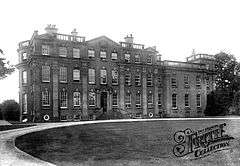Buntingsdale Hall
Buntingsdale Hall is a historic country house in the parish of Sutton upon Tern, to the southwest of Market Drayton in Shropshire, England. It became a Grade II* listed building on 14 February 1979.[1]
| Buntingsdale Hall | |
|---|---|
 | |
 Location within Shropshire | |
| General information | |
| Location | Tayleur Drive, Sutton upon Tern, Market Drayton |
| Town or city | Shropshire |
| Country | England |
| Coordinates | 52.8892°N 2.5146°W |
| Completed | 1721 |
| Design and construction | |
| Architect | John Prince and Francis Smith of Warwick |
History
Buntingsdale Hall was first built for Bulkeley Mackworth and the Mackworth family between 1719 and 1721.[2][3] The plans for the building were drawn up by the London architect and surveyor John Prince,[4] although it was completed by Francis Smith of Warwick.[3] Documents have revealed that Mackworth may have encountered a dispute with Prince and dismissed him and hired Francis Smith to complete the building.[1] The estate formerly included the remains of Fordhall castle, a monument scheduled under the Ancient Monuments and Archaeological Areas Act 1979 ("Ringwork and bailey castle 390m west of Buntingsdale Hall, List entry Number 1019659")[5]
Herbert Mackworth later sold the hall to his cousin William Tayleur, who subsequently owned the property for many years.[6] He gives his name to Tayleur Drive, the road that leads to the hall.
In 1986, during the time that a survey was conducted of the property, it was reported that a number of furnishings had been stolen from the hall.[1] By 2000 the hall was in disrepair and was placed on the Historic Buildings at Risk register. Subsequently it was renovated and was finally removed from this register in 2004.[2]
Over the years the hall has been owned by many different families but the current owners are Mackworths, direct descendants of Bulkeley Mackworth.[7][8]
Structure
The house is dated "1721" on the lead downpipe straps. It was extended and altered by Samuel Pountney Smith of Shrewsbury in 1857.[1] It is a three-storey red brick building with red sandstone ashlar dressings, featuring some fluted pilasters and a Corinthian stone doorcase consisting of pilasters, each supporting a section of entablature. The rainwater heads are emblazoned with the Mackworth arms and crest, and an acanthus ornament at the junction of pipes and cornice, and straps have the initials "BM" and the date "1721".[1]
The north wing is dated to 1857, with identical east and west fronts, when the staircase was moved and the full-height entrance hall was created. The entrance hallway has black and white stone flooring and bolection-moulded panelling up to first floor level with cornice.[1] The first-floor gallery above with turned balusters is raised to centre, and the central first-floor doorway is made up of fluted pilasters and an open triangular pediment.[1] It features a stone fireplace with cable-fluted Ionic columns. The dining room features a rich cornice with vine trail and egg and dart enrichment that was added in 1857, when the fireplace was removed.[1] The ballroom also features the same style as the dining room, with rich plaster panelling.[1]
A garden was initially laid out with the house, covering an area of 16 hectares.[2][3] The River Tern passes to the north of Buntingsdale Hall, with the main garden retaining wall west of the house, and an apsidal bow overlooking the pond.[3] The grounds were altered several times during the 18th and 19th centuries and walled gardens, a kitchen garden (to the north), grassland (east), large fishpond and boathouse (west), and woodland (to the south) were added.[2][3] By the end of the 19th century, a new entrance from the north and a lodge had been added.
See also
References
- "Buntingsdale Hall". British Listed Buildings. Retrieved 10 August 2010.
- "Buntingsdale Hall, Market Drayton, England". Parks and Gardens. Archived from the original on 11 March 2012. Retrieved 10 August 2010.
- "Buntingsdale Hall, SMRNO07571". Discover Shropshire. Retrieved 10 August 2010.
- References to Prince in the fragmentary buildings accounts. Prince was also the architect of Cound Hall, Salop., "remarkable for the ambitious but inept use of a giant Corinthian order applied to the main elevations" (Howard Colvin, A Biographical Dictionary of British Architects, 1600-1840, 3rd ed. 1995, s.v. "Price, John").
- Historic England. "Details from listed building database (1019659)". National Heritage List for England. Retrieved 19 May 2012.
- Lee, John Robinson (1861). A history of Market Drayton. Longman, Green, Longman, and Roberts. p. 126.
- "Drayton Walks" (PDF). Food Connection. Archived from the original (PDF) on 22 July 2011. Retrieved 10 August 2010.
- "Richard Mackworth - obituary". The Telegraph. Retrieved 27 August 2015.